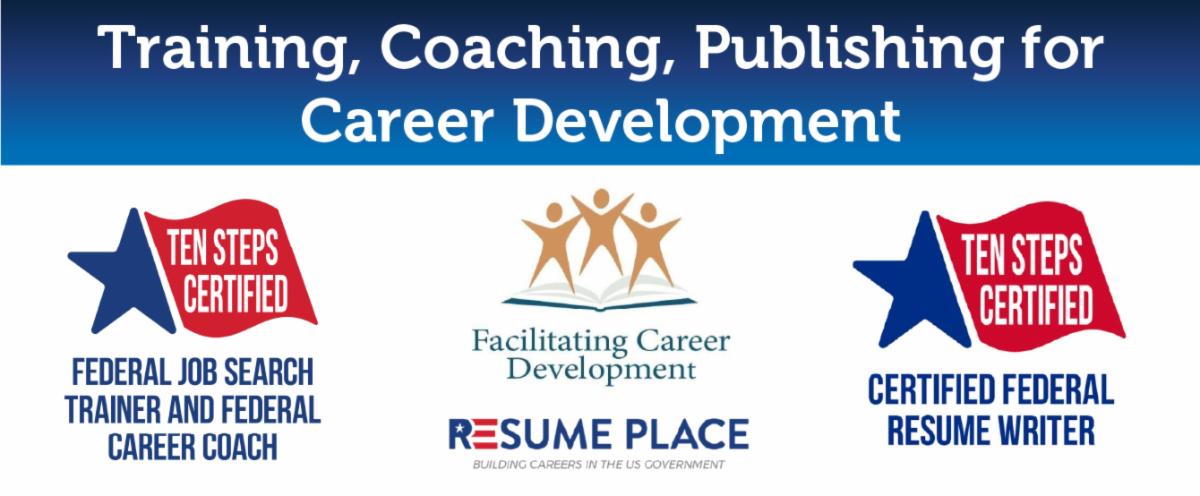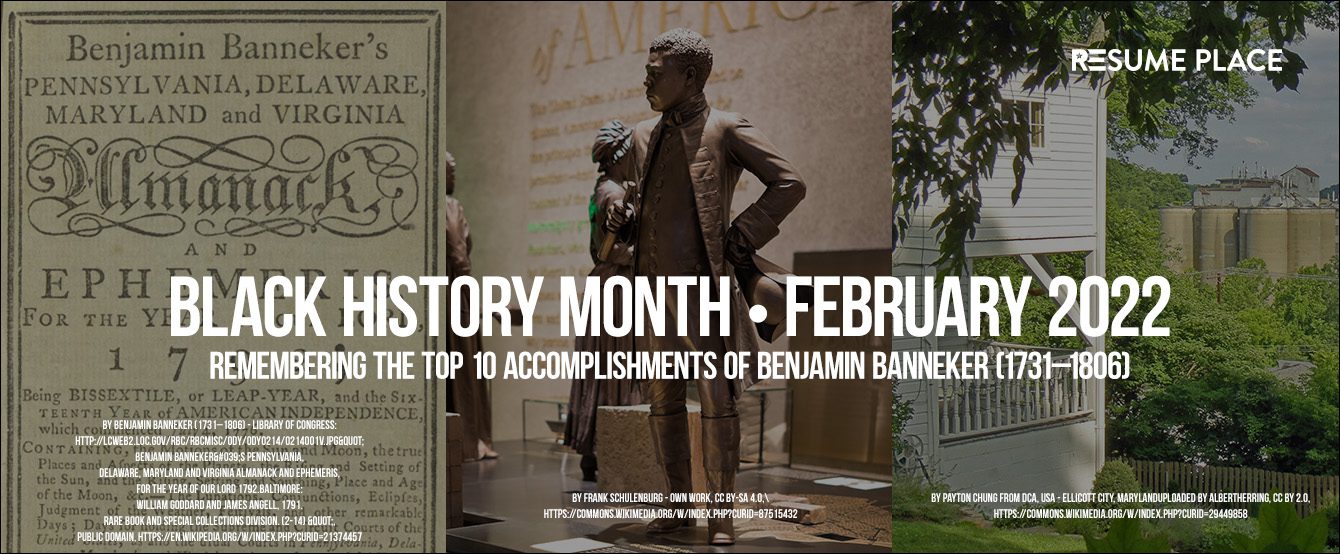February 9, 2022, Cabin John, MD
by Kathryn Troutman, Federal Career Coach®, President, Resume Place, Inc.
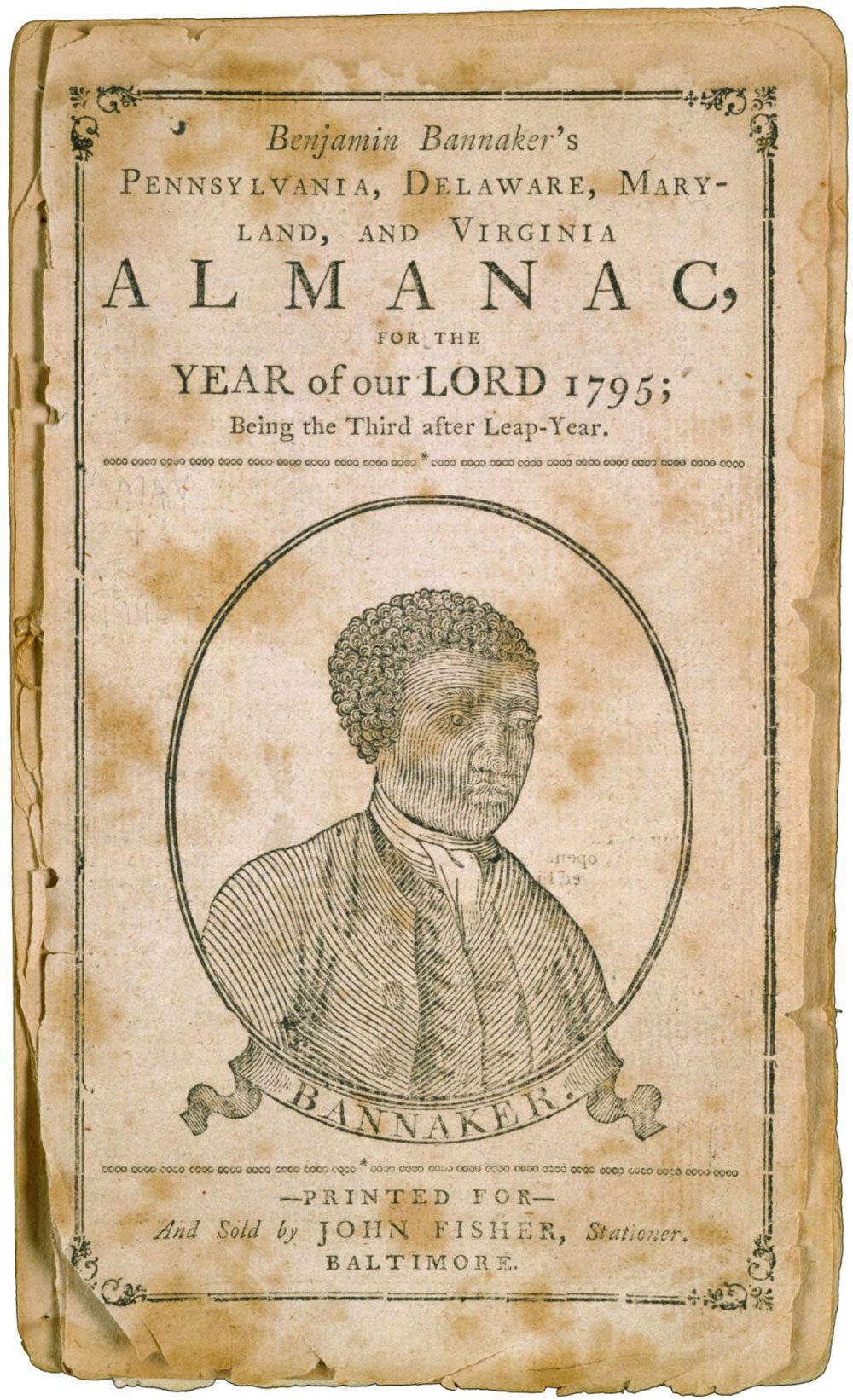
Portrait of Benjamin Banneker from the cover of his 1795 Almanac. Courtesy of the Maryland Historical Society
“I apprehend you will embrace every opportunity, to eradicate that train of absurd and false ideas and opinions, which so generally prevails with respect to us [African Americans]; and that your sentiments are concurrent with mine, which are, that one universal Father hath given being to us all; and that he hath not only made us all of one flesh, but that he hath also, without partiality, afforded us all the same sensations and endowed us all with the same faculties…”
Benjamin Banneker to Thomas Jefferson. August 19, 1791
As a Federal Career Coach, I urge our clients and students every day to compile their Top Ten Accomplishments, which inform both their resumes and their senior executive applications. Benjamin Banneker’s Top Ten List is amazing! Edited and enhanced by Nicole Schultheis, J.D., Senior Executive Service Top Ten List of Accomplishments Executive Coach.
Benjamin Banneker (1731 – 1806), was born in Baltimore County, Maryland to an African slave named Robert, who bought his own freedom, and Mary Banneky, the daughter of an Englishwoman and a free African slave. With little formal education, he taught himself mathematics, astronomy and natural history. This free, African American man went on to become a successful farmer, almanac author, and surveyor. He became known for assisting Major Andrew Ellicott in the original survey which established the borders of the District of Columbia. One of the first African Americans to gain distinction in the sciences, he corresponded with prominent political figures and shaped how African Americans were viewed during its earliest periods. Since his death in 1806, his accomplishments have continued to inspire all Americans. And, as the first Black astronomer in the United States, Banneker is recognized by many as one of the Black Americans whose extraordinary contributions paved the way towards eventual space exploration.
Benjamin Banneker’s
Top Ten List of Accomplishments
1. Successes in Farming. Banneker inherited the farm he had grown up on, which was left to him by his grandparents. Still a young man, he expanded the already successful farm, using crop rotation and irrigation techniques that weren’t yet popular. He his profitable tobacco crops were sold alongside his produce in the Ellicott family’s country store.
2. Clock Design. At the age of 30, Banneker designed and carved entirely out of wood a clock that struck on the hour. He modeled his clock upon a borrowed pocket watch. The clock, made in 1761, was apparently still ticking away at the time of his death.
3. Supporting the American Revolution. Taking heed of food shortages during the Revolutionary War, Banneker swapped his tobacco crop out for wheat which was used to help feed American soldiers.
4. Advancements in Astronomy. Growing up on his family’s 100-acre farm west of Baltimore, Maryland, Banneker taught himself astronomy by watching the stars. Having only a rudimentary formal education, he taught himself advanced mathematics from borrowed textbooks. In 1789, Banneker’s calculations enabled him to successfully forecast a solar eclipse. His accurate prediction, well in advance of the event, contradicted those of better-known mathematicians and astronomers.
5. Surveying the Original Borders of DC. Banneker’s abilities impressed then Secretary of State Thomas Jefferson, who recommended him to surveyor Major Andrew Ellicott (son of Joseph Ellicott, one of the founders of Ellicott City, Maryland). Beginning in 1791, Banneker used his astronomical calculations to establish the base points for the new District of Columbia. Banneker used his clock to relate points on the ground to the positions of stars.
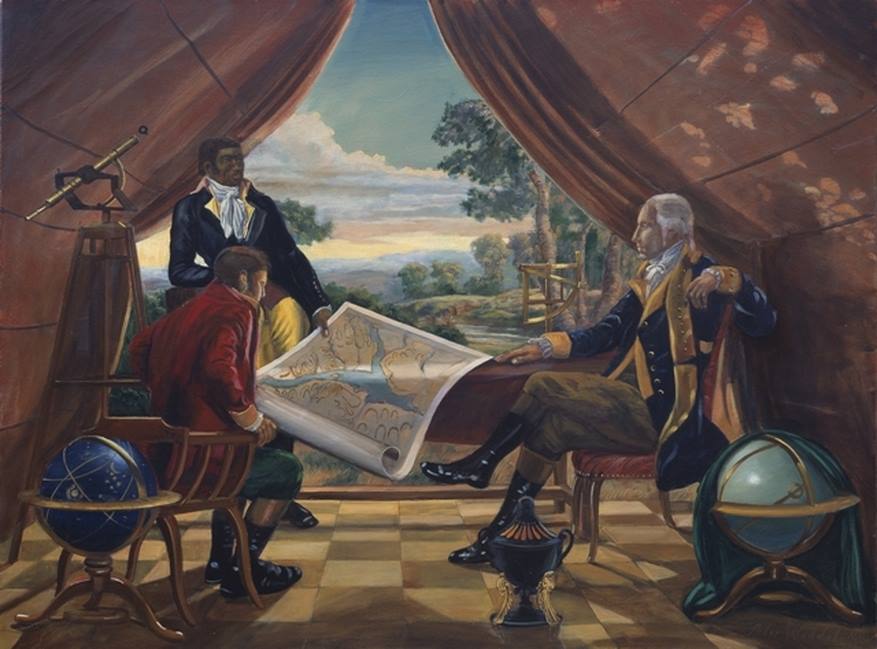
Survey of the original boundaries of the District of Columbia
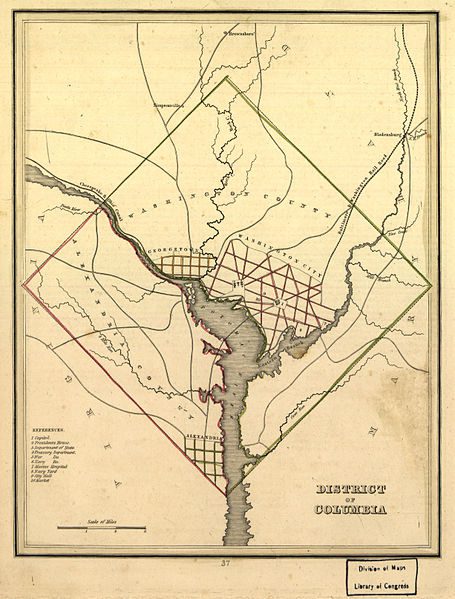
Surveyor – 1835 map of the District of Columbia showing Washington City in its center, Georgetown to the west of the city, and the town of Alexandria in the District’s south corner.
6. Almanac Author and Publisher. Benjamin Banneker used his informed calculations to create an almanac, which also included information on medicines and medical treatment. His almanac projected the tides, relayed astronomical information, and stated the dates of the eclipses he had calculated. Banneker’s Pennsylvania, Delaware, Maryland and Virginia Almanack and Ephemeris, for the Year of our Lord, 1792 was the first to be printed and sold. At least 28 editions appeared, in five cities: Baltimore, Maryland; Philadelphia, Pennsylvania; Wilmington, Delaware; Alexandria, Virginia; Petersburg, Virginia; Richmond, Virginia; and Trenton, New Jersey. The almanac was published between 1791 and 1802.
7. Promoting the Cause of Abolition. On August 19, 1791, when Banneker sent a copy of his first almanac to Thomas Jefferson, he included a cover letter. In it, he questioned the sincerity of Jefferson, a slaveholder, as a “friend to liberty.” Banneker urged the future president to fight for the abolition of slavery. Jefferson wrote back, revealing his ambivalence, while endorsing Banneker’s accomplishments. Though Jefferson told Banneker he had forwarded the almanac to the French philosopher the Marquis de Condorcet for the purpose of dispelling racial prejudices, Jefferson failed to advance the cause further.
“[N]o body [sic] wishes more sincerely than I do to see such proofs as you exhibit, that nature has given to our black brethren, talents equal to those of the other colours of men, and that the appearance of a want of them is owing merely to the degraded condition of their existence both in Africa & America….”
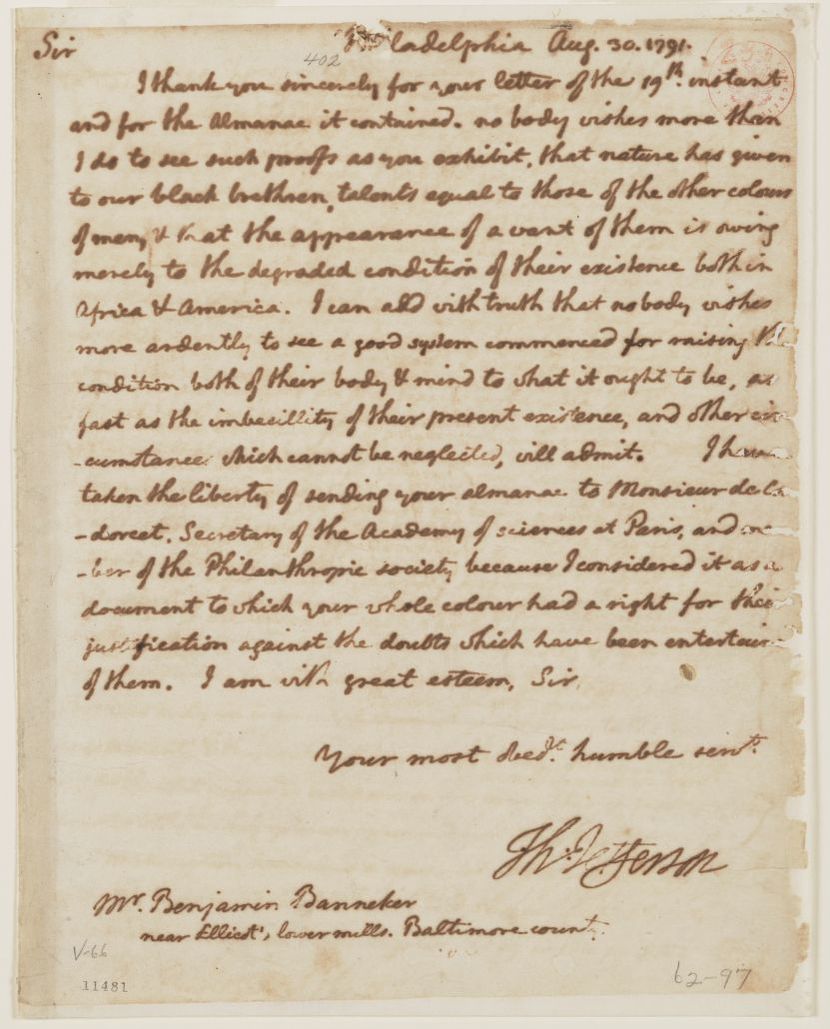
Letter, Thomas Jefferson to Benjamin Banneker expressing his belief that blacks possess talents equal to those of “other colours of men,” 30 August 1791.(Thomas Jefferson Papers). Manuscript Division
Meanwhile, impressed with Banneker’s astronomical calculations, Andrew Ellicott touted Banneker’s work to James Pemberton, the president of the Pennsylvania Society for Promoting the Abolition of Slavery and for the Relief of Free Negroes Unlawfully Held in Bondage. It was Pemberton who was then responsible for forwarding the almanac to others and enabling its publication.
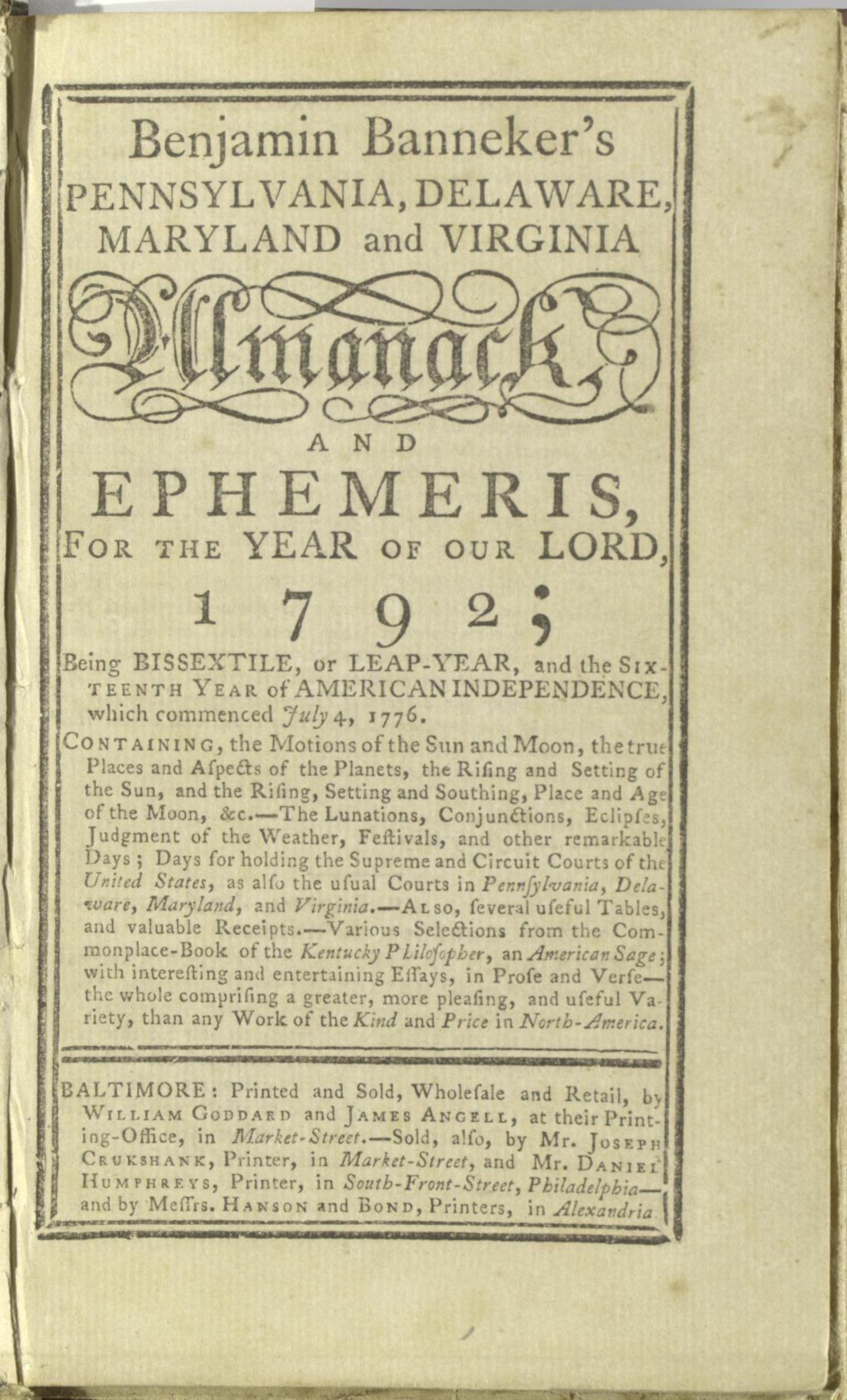
Title page of the Baltimore edition of Banneker’s 1792 almanac and ephemeris
8. Persistence—Creating a Public Record and Continuing to Advance the Cause. Banneker was not deterred by Jefferson’s ambivalence towards slavery. Jefferson chose to see Banneker’s achievements as exceptional, and wasn’t swayed by Banneker’s political, religious, and ethical arguments. So in 1793, Banneker had the letters he’d exchanged with Jefferson printed in his annual almanac. In his almanac he also published the essays and poetry of African American poet Phillis Wheatley and the English anti-slavery poet William Cowper, as well as anti-slavery speeches and essays from England and America.
9. Promoting Public Health and Pandemic Response. Ahead of his time, Banneker also shared knowledge which informed science-based public health policy, using his almanac to do so. The Philadelphia edition of Banneker’s 1795 almanac reported upon the yellow fever epidemic which struck the city in 1793. He included and account authored by a committee led by the city’s mayor. The report related the presumed origins and causes of the epidemic, as well as the extent and duration of the event.
10. Advancing the US Census—Mindful of Race, Gender and Representation. Banneker also used his almanac to share results of the US Census. The Baltimore edition of Banneker’s 1796 almanac contains a table enumerating the population of each US state and the Southwest Territory as recorded in the 1790 United States census. The table lists the number of free persons and slaves in each state and the territory according to race and gender, as well as to whether they were above or below the age of 16 years. The table also listed the number of members of the U.S. House of Representatives that each state had during the almanac’s year.
Note from the article author, Kathryn Troutman: Researching and writing Benjamin Banneker’s achievements has been so much fun! Over the past 40 years, my parents, my two brothers (Ted and Rob), my son (Chris), and I have all owned homes near or adjacent to the 142-acre Benjamin Banneker Historical Park and Museum. The park, which features a replica of Banneker’s log cabin, is a vibrant community asset. My grandkids often play on the park’s grounds, which today form part of the proud and historic community of Oella, which features its own bakery, butcher shop, community center and country store, adjacent to Ellicott City, Maryland.
Kathryn Troutman is the Founder and President of Resume Place, Inc., a Federal Career Consulting business located in Baltimore, MD. Her firm specializes in writing and designing professional Federal resumes, as well as consulting, coaching and education on the Federal hiring process. She is the author of many Federal career books, including the popular Federal Resume Guidebook, 7th Ed. (the #2 best-selling resume book on Amazon).
ORDER THE FEDERAL RESUME GUIDEBOOK HERE
